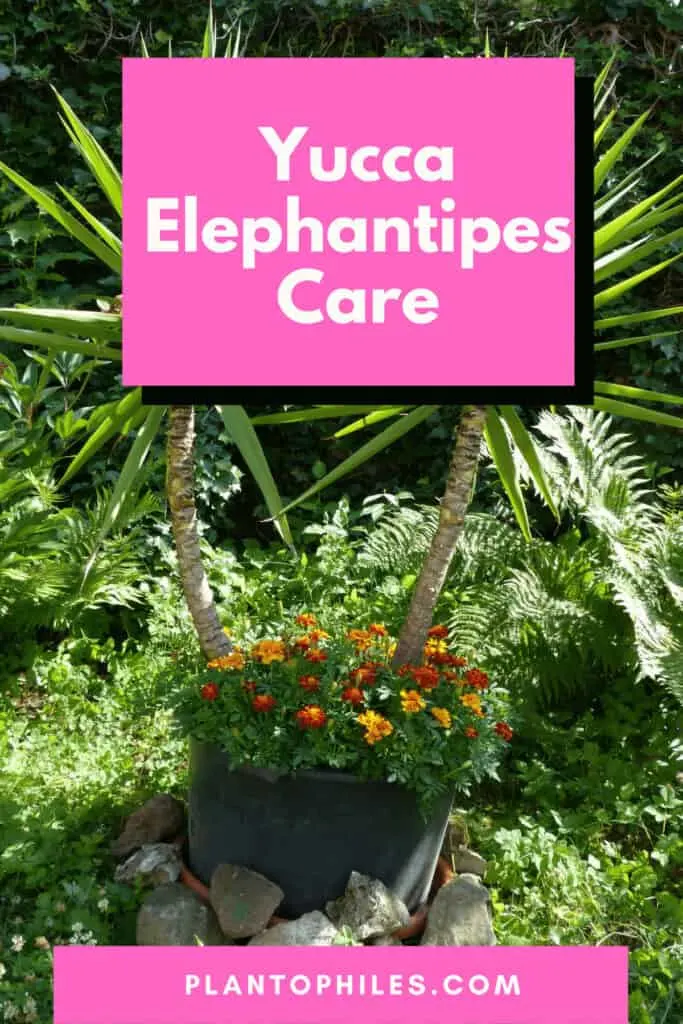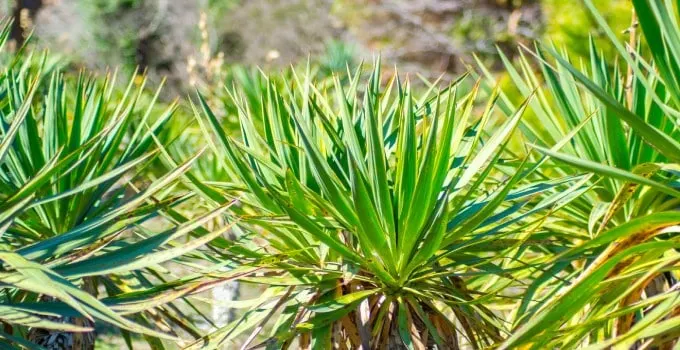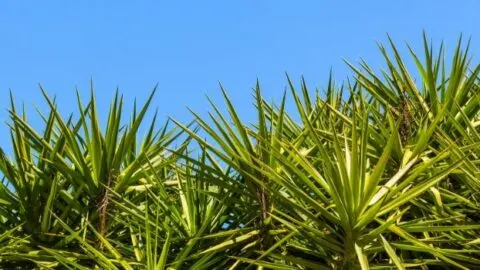If you want to bring a touch of the exotic right into your four walls, then Yucca elephantipes, also known as Yucca gigantea, Spineless Yucca, or even Giant Yucca, is the perfect fit.
With its spiky, green leaves, this woody shrub certainly makes for a great addition to any plant lovers’ houseplant collection, as it is very pleasing to the eye and pretty easy to care for. This is how I care for mine.
Table of Contents
Yucca elephantipes Care
To care for Yucca elephantipes use well-draining soil. It thrives in bright, indirect light. Water every 20 days.

Soil
Yucca elephantipes is not picky about soil. As long as you are using well-draining soil, you should be fine. A soil pH between 6 and 7 yields the best results.
If you are aiming for the perfect soil mix, you might want to enrich your potting soil with coarse sand and perlite. This will ensure excellent drainage.
Light
Yucca elephantipes needs a lot of bright, indirect sunlight. It can also tolerate some direct sunlight from time to time.
Watering
Water Yucca elephantipes every 20 days on average.
The most important rule when watering your Yucca palm is: Don’t overwater. This Yucca palm only needs a moderate amount of water. Water whenever the top layers of the compost have dried out. In winter, reduce watering.
The elephantipes stores water in its trunk. When I had my first plant years ago, I didn’t know this and was adding too much water. The result was that the stem got soft and mushy, which meant the end for my plant. Now, whenever I have a plant with a thick trunk, I assume it can store water well and needs only a little.
Temperature
When caring for this Yucca, you won’t have to bother too much about the right temperature, as anything between 7 to 24 degrees (44 up to 75 Fahrenheit) will be tolerated by your woody friend.
Humidity
Palms are usually not in need of high levels of humidity. This also holds for Yucca elephantipes: This evergreen shrub does best in average room temperature & humidity.
However, especially in winter, you should make sure that the air humidity is not too low, as this brings with it the risk of the plant being attacked by pests on the one hand, and the other hand, it can dry out the leaf tips of the palm.
Fertilizer
Feed your Yucca twice a week with a liquid fertilizer during the growing season in spring and summer. Use
When the plant is resting in winter, you won’t need to feed it at all.
Also, feeding your Yucca won’t be necessary in the first year of cultivation/after repotting.
The general rule of thumb when fertilizing is always the same: In doubt, fertilize less. Feeding too little is often not a big issue, whereas overfertilizing can literally kill your plant.
Yucca elephantipes Propagation
Propagation of Yuccas is easy. In fact, Yucca elephantipes is basically self-propagating, as it produces small offsets around the stems. To propagate, all you need to do is to take these offsets out and repot them. Very easy, indeed.
Seed propagation is another good way to produce yucca babies.
You can also multiply your Yucca palm through stem cuttings.
If propagating houseplants is something that you are particularly interested in, make sure to have a look at our article: The 12 easiest plants to propagate.
Growth
When kept outdoors, Yucca elephantipes, also Spineless Yucca, is often used as a landscape element. It can reach 30 feet in height (about 9 meters). Its spiky leaves alone can reach about 4 feet (1.2 meters).
When grown indoors, these individuals obviously won’t grow all that tall. They can still grow up to 10 feet tall, though. Hence, with Yucca elephantipes, regular pruning might still be a necessity.
Potting
Regular repotting of your Yucca elephantipes is not a requirement. Repotting should be done about every two years. As this plant is known to be top-heavy, you should always use deep containers when repotting. Repotting your Yucca is best done in spring.

The watering basics for your Spineless Yuca
During the growing season, the palm should be thoroughly watered. The excess water coming out of the drainage hole should be removed shortly after watering, as otherwise the roots of the palms may be damaged.
Before watering again, the top layers of soil (the top 4-5 cm) should be allowed to dry out completely.
How long will this take?
This could be anywhere between 2 to 3 days later up to a week or even longer, depending on various factors such as the size of the pot, the soil, the location, the size of the palm tree itself, and the actual season.
It is, therefore, best to use your finger to check if the top layer of the soil is dry or not. If it is indeed dry, then bless your Yucca palm with some more water.
During the resting period (mainly during colder winter months), the water regimen needs to be adjusted. Generally speaking, during winter, watering needs to be reduced a lot.
The rule of thumb here is to keep the soil only moderately moist. The colder the temperatures get, the less water your Yucca will need.
Yucca Plant Propagation Techniques
There are three possible ways to propagate Yucca elephantipes: Propagation through stem-cuttings, propagation from seeds or a simple repotting of offshoots (Yucca elephantipes “automatically” produces offshoots around the stems).
Propagation through repotting of offshoots is probably the easiest method to propagate the plant.
Propagation through seeds is also easy, but it takes some (more) time.
Propagation through stem cuttings is both easy & fun. If your Yucca palm is getting too big, you might need to prune it anyway (by cutting the main stem!). At that point, you can simply grow a new plant from the remaining stem and the new stem cuttings.
Propagating Yucca elephantipes through stem cuttings
- Use sharp, sterile scissors to cut the desired stems. Take cuttings from mature stems (stems with dark brown bark).
- Remove the lower leaves of the stem.
- Air-dry the freshly taken cuttings for about an hour or two.
- Fill a new pot with vermiculite, and then root the cutting. One cutting per pot is fine. Using big pots, you could also root several stem cuttings in the same pot.
- From time to time, water your Yucca babies.
- After 3-4 weeks, the roots should begin to form.
- When the roots are long enough, repot the new plant and put it in a new soil mix. Water thoroughly and then go back to regular Yucca plant care.
Note: As for the mother plant, when you see new buds forming (at the locations where you did the cuttings), you may want to transplant the mother plant as well.
Propagating Yucca elephantipes from seeds
If you want to make new Yucca plant babies, you might also propagate through seeds. This method is not difficult, however, it takes some time (at least two months).
Here’s how you do it:
1. Place the Yucca elephantipes seeds in lukewarm water and keep them there for about a day
2. Place the seeds in the soil mix of your choice (seedling soil or coconut fiber produces good results) and just slightly cover them with soil.
3. Use a spray bottle to water the seeds. Keep the substrate moist.
4. Give it some time. Germination takes a long time and you might need to wait up to two months until you see results. Patience is key here.
5. Then, when your Yucca plant babies reached a height of about 15-18 cm (about 6 inches), give them a new home (repot them, use fresh soil).
Overwintering Yucca elephantipes
Whether you had your Yucca palm outside in summer or cultivated it indoors all year round, you won’t need to move your leafy friend to a different spot in winter.
As pointed out earlier on, this Yucca feels comfortable in a wide range of temperatures and is generally not susceptible to sudden changes in temperature.
That said, you can keep your Yucca in the same spot as in summer. However, as with many other plants, watering should be reduced in winter.
Spineless Yucca Pests
The pest resistance of this woody friend is pretty remarkable. But nobody is perfect. Not even our Yucca.
Three pests to look out for when growing Yucca elephantipes are scale, black weevil & mealybugs.
Spineless Yucca Diseases
Spineless Yuccas are pretty much disease-free.
One thing you will need to look out for, however, is root rot. Root rot typically occurs when the compost is kept too moist.
Yellowing Leaves on a Yucca Plant
It is pretty common to have a couple of yellow leaves on your Yucca elephantipes. The reason for this could be both over- or underwatering. Beginners tend to overwater the Yucca plant.
Try adjusting the watering regimen, and if that does not help, you can also sporadically remove (cut off) yellowing leaves.
Stunted growth
Generally speaking, the spineless Yucca is a fast-growing plant. If it does not grow as expected, this could be a sign that your Yucca does not get enough sunlight.
A lack of sunlight causes your Yucca to grow at a lower rate or even stunts the growth completely.
Droopy Leaves on a Yucca
A healthy Yucca elephantipes sports stiff, upright leaves. If its leaves are droopy, there is definitely something wrong with the plant. More often than not, droopy leaves indicate that your Yucca is not getting enough sunlight.
Move your Yucca palm to a brighter spot to solve this problem.
Spots on the leaves
If you do find weird-looking spots on your Yuccas’ leaves, then this could very be due to watering your plant with limewater. It is best to water your Yucca with soft water that is low in lime. Distilled water or rainwater yields good results.
If you do find black spots or brown spots on the leaves, you could also be dealing with plant pests (bacteria or fungi).
Is Yucca elephantipes difficult to care for?
Yucca elephantipes care is pretty easy. Even for beginners. Provide this shrub with a sufficient amount of sunlight (bright light with the occasional direct light) and make sure to water it moderately from spring to autumn, whenever the top of the soil dried out. If you take this simple care advice to heart, your Yucca palm will likely thrive.
Yucca elephantipes care is pretty similar to Ponytail palm care.
FAQ
What is the difference between Yucca gigantea and Yucca elephantipes?
We are actually talking about the same plant here. Yucca gigantea is the official (and more correct) name for the plant. However, Yucca elephantipes is more commonly used.
Can you grow Yucca elephantipes indoors?
Absolutely. You can cultivate Yucca elephantipes indoors all year round. Alternatively, you can also keep it outside during summer and then bring it inside when temperatures start to drop.
Is Yucca elephantipes poisonous to cats & dogs?
The spineless Yucca is considered harmless to adults. However, it is poisonous to cats & dogs. Therefore, for the well-being of your pets, keep this plant away from both cats & dogs.
Does Yucca elephantipes flower when cultivated indoors?
Yucca elephantipes rarely flowers when cultivated as an indoor plant.
How tall can Yucca elephantipes grow?
In their natural habitat, Yucca elephantipes palms grow up to 30 feet tall. This shrub can still get up to 10 feet tall when cultivated indoors.
What are the common names of Yucca elephantipes?
Yucca elephantipes also goes by the names of Yucca gigantea (official name), spineless Yucca, Yucca cane & giant Yucca.
My Yucca palm is getting too big. What should I do?
If your Yucca palm outgrows its space (is getting too tall), you might need to prune it. To do so, you can simply cut the main stem of the palm. And please don’t worry. This is not the end of your mother plant! You can now use the stem to grow a new plant or even several new plants by dividing the stem into multiple sections and by placing them in potting soil.
The Last Palm
Yucca elephantipes is an ideal drought-tolerant plant that is easy to care for and adds a tropical touch to your indoor and outdoor environment.

Daniel has been a plant enthusiast for over 20 years. He owns hundreds of houseplants and prepares for the chili growing seasons yearly with great anticipation. His favorite plants are plant species in the Araceae family, such as Monstera, Philodendron, and Anthurium. He also loves gardening and is growing hot peppers, tomatoes, and many more vegetables.


